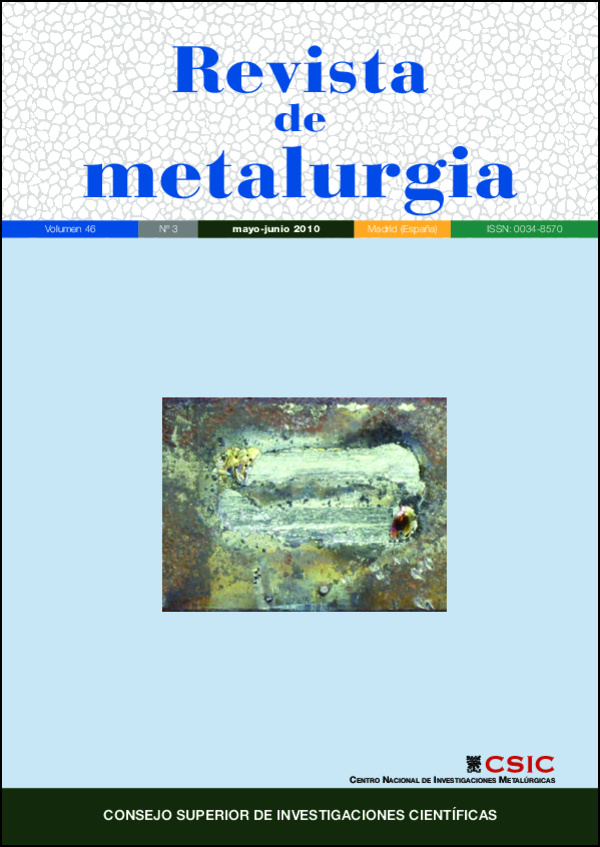Modification of AISI M2 high speed tool steels after laser surface melting under different operation conditions
DOI:
https://doi.org/10.3989/revmetalm.0918Keywords:
AISI M2 high speed steel, Nd, YAG laser, Laser melting, Hardness, WearAbstract
We applied a laser surface melting treatment to AISIM2 high-speed steel –hardened and tempered- and studied the resulting surface characteristics (microstructure) and mechanical behavior (hardness and wear performance). The steel was treated using a Nd:YAG continuous-wave laser with different operation conditions. The influence of the laser processing parameters on the single tracks and on melted surface layer obtained by multipass system with 50% overlap were studied. The microstructure for all conditions is formed byMC- and M2C-type carbides, martensite and retained austenite; the quantities of this phase depends on the operations conditions. It has been determined that low levels of power density and high speed scanning of the beam leads to greater homogeneity in the microstructure with high hardness values and wear resistance.
Downloads
References
[1] G. Roberts, G. K. Krauss y R. Kennedy, Tool Steels, ASM International, EEUU, 1998, pp. 251-289.
[2] Tool Materials, ASM International, EEUU, 1995, pp. 119-153.
[3] W.M. Steen, LaserMaterials Processing, Springer Verlag, Berlin, Alemania, 1998, pp. 435-543.
[4] G.Muñiz, A. Conde, B. J. Fernández, R. Varela, I. Garcia y J. De Damborenea, Rev. Metal. Madrid 39 (2003) 443-451.
[5] S. Kac y J. Kusinski, Surf. Coat. Technol. 180-181 (2004) 611-615. doi:10.1016/j.surfcoat.2003.10.104
[6] C. Navas, A. Conde, B. J. Fernández, F. Zubiri y J. de Damborenea, Surf. Coat. Technol. 194 (2005) 136-142. doi:10.1016/j.surfcoat.2004.05.002
[7] W. Darmawan, J. Quesada y R. Marchal, Surf. Eng. 23 (2007) 112-119. doi:10.1179/174329407X169502
[8] R. Colaco, C. Pina y R. Vilar, Scr. Mater. 41 (1999) 715-721. doi:10.1016/S1359-6462(99)00206-7
[9] C. T. Kwok, F. T. Cheng y H. C. Man, Surf. Coat. Technol. 202 (2007) 336-348. doi:10.1016/j.surfcoat.2007.05.085
[10] S. Kac, J. Kusinski, A. Zielinska-Lipiec y I. Wronska, J.Microsc. Oxford 224 (2006) 65-67. doi:10.1111/j.1365-2818.2006.01666.x PMid:17100909
[11] M. Boccalini y H. Goldenstein, Int.Mater. Rev. 46 (2001) 92-115. doi:10.1179/095066001101528411
[12] S. Kac y J. Kusinski, Mater. Chem. Phys. 81 (2003) 510-512. doi:10.1016/S0254-0584(03)00062-2
[13] J. Kusinski, Appl. Surf. Sci. 86 (1995) 317-322.[14] J. Kusinski, Metall. Trans. A 19 (1988) 377-382. doi:10.1007/BF02652548
[15] L. Ahman, Metall. Trans. A 15 (1984) 1.829-1.835.
[16] K. Y. Benyounis, O.M. Fakron, J.H. Abboud, Mater. Design 30 (2009) 674-678
[17] G. Hoyle, High Speed Steels, Butterworths, London, UK, 1988, pp 10-24.
[18] R. Colaco y R. Vilar, J. Mater. Sci. Lett. 17 (1998) 563-567. doi:10.1023/A:1006573620796
[19] R. Colaço y R. Vilar, Mater. Sci. Eng. A 385 (2004) 123-127.
[20] R. Colaco y R. Vilar, Rev. Metal. Madrid 34 (1998) 135-139.
[21] R. Colaco, E. Gordo, E. M. Ruiz-Navas, M. Otasevic y R. Vilar,Wear 260 (2006) 949-956.
[22] J. Arias, M. Cabeza, G. Castro, I. Feijoo, P. Merino y G. Pena, X Congreso Nacional de Materiales, San Sebastián, España, 2008, Universidad de Mondragón (Eds.), San Sebastián, España, 2008, pp. 101-104.
[23] H. Fredriksson y S. Brising, Scand. J. Metall. 5 (1976) 268-275.
[24] J.A. Pero-Sanz, Aceros, Ed. Dossat, Madrid, España, 2004, pp. 64-81.
[25] D. H. Bhadeshia y R. Honeycombe, Steels: Microstructure and Properties, Butterworths, Oxford, Inglaterra, 2006, pp. 95-120.
[26] G. W. Stachowiak, A. W. Batchelor y G. B. Stachowiak, ExperimentalMethods in Tribology. Elsevier, Amsterdam, Holanda, 2004, pp. 170-179.
Downloads
Published
How to Cite
Issue
Section
License
Copyright (c) 2010 Consejo Superior de Investigaciones Científicas (CSIC)

This work is licensed under a Creative Commons Attribution 4.0 International License.
© CSIC. Manuscripts published in both the printed and online versions of this Journal are the property of Consejo Superior de Investigaciones Científicas, and quoting this source is a requirement for any partial or full reproduction.
All contents of this electronic edition, except where otherwise noted, are distributed under a “Creative Commons Attribution 4.0 International” (CC BY 4.0) License. You may read the basic information and the legal text of the license. The indication of the CC BY 4.0 License must be expressly stated in this way when necessary.
Self-archiving in repositories, personal webpages or similar, of any version other than the published by the Editor, is not allowed.
















